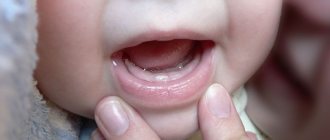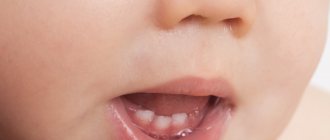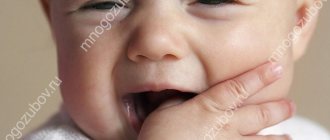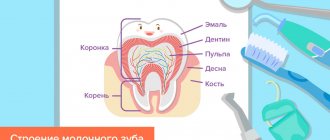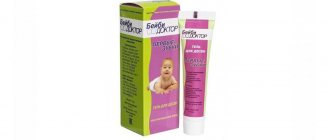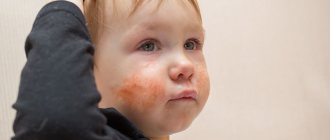At 4 months, primary teething often occurs. The child cannot independently communicate what exactly is bothering him, so strong crying appears. It gets worse at night. Some children tolerate this period calmly, while in others it manifests itself with negative symptoms, pain, and increased body temperature. If a child’s baby teeth begin to erupt before 4 months, it is necessary to look for deviations in health. Normally, they should appear at 4-6 months, so parents should monitor for symptoms.
The process of tooth formation in a child up to one year old
Babies' teeth grow in pairs. A child's lower teeth come in first at 4 months; the upper row fills in within 2 months. Then expect the appearance of the lower and upper lateral incisors, first molars, canines and second molars. By the age of three years, the set of teeth totals 20 units.
Laying the primordia
At the seventh week, temporary teeth are formed in the mother’s womb, and at the 17th week, the rudiments of permanent incisors are formed. Sixteen permanent teeth are formed during the embryonic period. The remaining follicles are observed after the baby is born: after 2 years - the 1st premolar, three years - the 2nd premolar and molar, five years - the 3rd molar.
Beginning of mineralization
The temporary teeth of the fetus are mineralized in the second half of intrauterine development. At six months of age, with the introduction of complementary foods, permanent teeth 1, 3, 6 appear.
End of mineralization
The average time for mineralization of the first premolars is 2-2.5 years, the second premolars and molars are 2.5-3.5 years, and from the age of 8 the third molars are mineralized.
Teething
The timing of the eruption of primary teeth for the upper and lower rows is determined individually.
The upper teeth appear in the following order:
- central incisors – 8…12 months;
- lateral incisors – 9…13 months;
- canines – 16…22 months;
- first molars – 13…19 months;
- second molars – 25…33 months.
Lower teeth:
- second molars – 3…31 months;
- first molars – 17…31 months;
- canines – 17…23 months;
- lateral incisors – 10…16 months;
- central incisors – 6…10 months.
Attention! Dr. Komarovsky recommends keeping a calendar to mark the appearance of new teeth. With a dental card, it is convenient to monitor compliance with standards, and it is easier to visit a pediatrician or dentist.
The procedure for replenishing the dentition
Pathological signs: when should you see a doctor?
Some symptoms that young mothers consider normal during teething are not directly related to the process and are the penetration of infection into the child’s body. Teething is stressful for the body, and the child’s immunity during this period is greatly weakened, which creates excellent conditions for the growth of pathogenic bacteria and viruses.
Listed below are typical signs that require consultation with a specialist, which cannot be considered as a physiological norm during the appearance of baby teeth in infants.
- Temperature . A slight increase in temperature is considered normal during the eruption of frontal incisors and canines, but it should not rise above the upper limits of subfebrility. If a child has a temperature of 38.1°C or higher, you should consult a doctor - an infection has probably occurred due to reduced immunity.
- Diarrhea. It is normal to loosen stools due to increased activity of the endocrine glands, but stools should not be too frequent, watery, or foul-smelling. There should be no changes in the color of the stool, so consultation with a doctor is necessary if the stool has changed consistency, color or smell.
- Cough . The physiological norm is a slight cough that occurs as a result of saliva flowing down the back wall of the larynx, but a frequent and prolonged cough always indicates a cold infection.
Any changes in the child’s well-being and behavior should be a reason for consultation with a pediatrician or pediatric dentist - only a doctor will be able to assess the baby’s condition and draw a conclusion about his health and the need for any therapy. Read the article for treatment of stomatitis at home.
Signs of teething in babies
Irritation from diapers in boys and girls - what to do
Pain accompanied by swelling of the gums causes discomfort and changes in the baby’s behavior. Signs of teething in a 4-month-old baby appear 3-5 days before the incisor comes out, and disappear as the gums break through.
Unreasonable anxiety
Along with hyperemia and swelling of the gums, there are general signs of teeth in a 4-month-old baby: restlessness, irritability, moodiness. They are nonspecific and occur in various infectious or inflammatory pathologies.
Swelling gums
A couple of days before teeth appear, the gums swell and turn red, the surface becomes loose, bumpy, and in rare cases, bruises appear.
Biting
When teething, newborns feel an irresistible urge to scratch their sore gums. Kids begin to bite various objects, their fists. A teether with a corrugated surface, made of hypoallergenic materials, will help alleviate the condition.
Grabbing ears
Pain in the gums spreads through the common pathways of the nervous system to the ears and cheeks. At the first symptoms of teething in 4-month-old infants, children hold their ears, rub their cheeks and chin.
Eats intermittently
In an effort to fill the mouth, slightly easing the aching and itching pain, the baby creates the impression of being constantly hungry. Resorption increases the feeling of discomfort, forcing you to abandon breastfeeding or the bottle that was previously in demand. A baby who eats solid food temporarily loses interest in the new diet.
Takes a long time to fall asleep
Crying, restless sleep at night, and mild fever also help you understand when to expect new teeth.
Constantly puts hands in mouth
The child constantly focuses on painful processes in the gum area, puts his hands in his mouth, bites hard objects, and strives to reduce unpleasant painful sensations in the gums.
The child bites his own hands
Symptoms of teething
There are common signs that indicate teething at an early age.
Tears, anxiety
The baby has the following signs:
- severe crying, whims;
- decreased appetite, refusal to drink food and water;
- letting go of the breasts while eating.
Symptoms are formed due to changes in the gums. As baby teeth begin to damage them, an inflammatory reaction is formed. It is accompanied by characteristic signs:
- pain;
- edema;
- inflammation.
Increased sensitivity of the gums causes severe anxiety and discomfort.
Dentists are one of the few doctors whose visits patients prefer to postpone. Therefore, treatment of advanced caries is not uncommon. Read more in the article: “they put arsenic, but the tooth still hurts.”
Increased salivation
With increased salivation, the following signs are formed that parents should pay attention to:
- copious amounts of saliva that may leak from the mouth;
- the child pulls objects into his mouth, bites and sucks.
Increased salivation does not always develop during teething. This may be a symptom of digestive problems, the development of oral fungus, and other diseases.
Loose stools
Impaired stool formation often occurs during teething. The condition is aggravated by the fact that from 4 months, most pediatricians recommend introducing the first complementary foods little by little. Therefore, parents do not always understand what exactly caused diarrhea. It is necessary to carry out differential diagnosis with the following conditions:
- eating poor quality food;
- inflammatory diseases of the gastrointestinal tract;
- intestinal infection when infected with pathogenic bacteria.
You should sound the alarm and consult a doctor only in the following cases:
- diarrhea occurs 3 times a day or more often;
- stool does not return to normal within 3-7 days.
In addition to the consistency of the stool, you need to pay attention to its contents. The presence of inflammatory or infectious pathologies of the gastrointestinal tract can be suspected in the presence of impurities of mucus, pus, and blood.
As you know, this is a disease associated with impaired absorption of glucose by the body and caused by insulin deficiency. The hormone works effectively: sugar entering the body is converted into glucose thanks to it. Read more in the article: “signs of diabetes in women after 40.”
The following stages of examination of the child are distinguished, which help to differentiate normal teething from an intestinal infection:
- the baby is first calmed down so that there is no strong crying;
- placed on a hard surface, such as a changing table;
- palpate areas of the child’s abdomen;
- if there is no crying, you remain calm, your stomach is soft, there is no reason to panic;
- if the stomach is hard, crying immediately appears, you need to consult a pediatrician, the child may be developing an intestinal infection.
Digestive disorders are often accompanied by vomiting and excessive regurgitation. The signs are also characteristic of the teething period.
Increased gum sensitivity
A four-month-old baby always experiences increased sensitivity when teething gums. It is accompanied by the following symptoms:
- swelling of soft tissues;
- severe redness;
- increased sensitivity;
- pain, itching, burning.
Teething brings great discomfort, so parents should remain calm around it. Mom should not worry, she needs to remain calm. If it is tense, the baby's condition will worsen.
At 4 months, the child has not yet learned to eat food in pieces. Therefore, it is forbidden to give him crusts of bread, large pieces of carrots and any other food that he might accidentally bite off and swallow. This risks causing the child to choke and begin to choke.
Less commonly, large pieces of food at this age can lead to the formation of small hemorrhages in the gums. They go away on their own, but can frighten young parents.
Fever, cough
The table shows the main signs by which you can differentiate between colds and teething.
| Symptom | Teething | Cold, infection |
| Hyperthermia | The temperature cannot rise above 38°. It can only last for 4 days, then it goes away on its own | With a cold, low-grade fever is observed. If the infection is serious, the temperature rises to 38-40° |
| Malaise | No | The child becomes very weak and refuses to eat food for a long time. |
| Cough | No | Since a 4-month-old baby spends more time lying down, sputum is difficult to come out, which is why a wet cough develops. If it is not treated promptly, wheezing develops in the trachea and bronchi due to the accumulation of sputum. |
| Rhinitis | A small mucous discharge from the nose that may drain into the throat. Symptoms last 2-3 days, then go away on their own without taking medications | Strong, long-lasting, not eliminated without medication. Mucous discharge may turn purulent and is accompanied by a yellow or green tint |
Strong, persistent crying, even after taking painkillers, may be characteristic of inflammatory processes in the ears. If otitis is suspected, contact an otolaryngologist; do not carry out self-therapy.
Symptoms of teething in a 4 month old baby
Toys for 8 month old baby
Depending on the individual characteristics of the organism, signs of the appearance of incisors appear to a greater or lesser extent.
Excessive salivation
The symptom appears 1-2 months before the appearance of the dental crown itself. Increased salivation is a protective reaction to itching and irritation of the gums. Also, babies do not automatically swallow saliva. The accumulation of fluid in the throat of a lying baby causes a reflex cough, the syndrome disappears in an upright position.
Sensitivity and itching of gums
Mechanical irritation of the sensory nerves of the gums indicates the preparation of teeth for eruption.
Temperature increase
A short-term (1-2 days before the formation of the edge of the dental crown) increase in body temperature up to 39 degrees occurs against the background of local inflammation of the soft tissue of the gums. The blood is saturated with biologically active elements that enhance heat generation.
Diarrhea
Malnutrition, excessive swallowing of saliva, increased intestinal motility in response to inflammation in the oral cavity provoke diluting of the stool. The disorder manifests itself 2-3 days before the visible crown of the tooth appears.
Refusal to eat
During periods of anxiety, every baby experiences a weak appetite, this is natural.
Rash
Irritation and rashes in the area of the mouth, chin and neck are typical reactions of the skin to constant moisture that appears with excessive salivation.
Cry
Whims, tears, jet lag are normal reactions of a child to itching, pain and inflammation of the gums.
Typical clinical picture: characteristic symptoms
Classic signs of teething in infants occur approximately 10-14 days before the tip of the upper or lower incisor appears on the gum surface. They are difficult not to notice, as they are of high intensity and affect the general well-being of the child. Parents should be aware of all these signs and symptoms in order to take timely measures and provide the necessary hygienic care and medication if needed.
Increased activity of the salivary glands
This is manifested by hypersalivation - increased salivation. During this period, the child has to be changed every 1.5-2 hours, as his clothes quickly become damp due to constantly flowing drool. Increased attention should be paid to hygiene: a humid environment causes irritation on the skin of the chin and neck and promotes the spread of pathogenic bacteria. A child with excessive drooling should be bathed daily, sometimes even 2 times a day. It is advisable to add a decoction of string or chamomile to the water (you can use regular table salt) - they will relieve inflammation, soothe the skin and eliminate itching.
Note! Secretory activity in some children may also be manifested by watery or mucous discharge from the nose. They should have a transparent color and liquid consistency. There is no need to worry about this phenomenon if the child has no signs of colds or respiratory diseases.
Change in body temperature
The appearance of the first teeth is a difficult process for a child’s body, accompanied by inflammation, to which the immune system reacts with a slight increase in body temperature. Usually this indicator remains within subfebrile values and does not exceed 38°C. If the child feels well, there is no need to lower the temperature. In case of severe discomfort, when the child refuses to eat and is not interested in surrounding objects and people, you can use drugs from the group of antipyretic drugs.
The drugs of choice for children under 1 year of age are those containing paracetamol or ibuprofen. They can be produced in the form of rectal suppositories or syrups for internal use. These include:
- "Ibufen";
- "Panadol";
- "Nurofen";
- "Paracetamol";
- "Ibuprofen."
Important! For children with a tendency to allergic reactions, it is better to use the drug in the form of suppositories (for example, Cefekon), since the oral forms contain aggressive dyes.
External gum changes
The surest way to determine that a child's teeth will begin to grow is to examine his gums. There is a whole range of symptoms that allow you to determine the imminent eruption. These include:
- swelling and swelling of the gums;
- the appearance of a white dense lump on the gum (the upper part of the erupting tooth), when pressed on which the child experiences severe pain;
- hyperemia of the mucous membranes at the site of eruption;
- itching of soft tissues (if a child scratches an inflamed gum, he will close his jaw tightly and make scratching movements);
- bleeding gums.
If the gums begin to bleed, it means that there is very little time left until the first tooth erupts - no more than 3-7 days.
Important ! These symptoms may indicate inflammatory gum disease, such as gingivitis or periodontitis. Despite the fact that they are rarely diagnosed in children in the first year of life, it is necessary to consult a dentist to rule them out. A white lump on the gum may be an abscess or abscess, so it is best to draw conclusions about the causes of the inflammatory process after a medical examination.
Rules for parents to follow
Physiological runny nose in a baby: how to recognize the symptoms
It is important for parents to know several important aspects required to comply with teething in children:
- It is necessary to visit the dentist periodically when new teeth need to emerge to form a proper bite.
- Teethers purchased for gums should be of medium hardness, exclude non-food dyes in the composition, and are likely to tear off a piece and swallow it.
- To avoid caries, teeth should be wiped with cleansing wipes or silicone finger brushes at four months. Later, doctors recommend carefully choosing toothpastes and brushes, taking into account the age and sensitivity of the child’s gums. It is advisable to brush your baby’s teeth twice a day (morning and evening after meals).
Using a teether
Important! With the introduction of complementary foods (cereals, vegetable, fruit and meat purees), many parents rush to find out the recommended amount of calcium and vitamins that strengthen teeth and enamel.
How to help your baby with teething
Pharmacies sell medications that relieve dental symptoms in children. Using plastic rings or rubberized toys helps reduce the load on the child's nervous system, preventing exhaustion.
The fact that teeth have begun to cut is indicated by copious salivation. Napkins or a towel will help remove excess moisture. While sleeping, you should place a napkin under the baby's head to absorb the liquid that is released; this measure will eliminate the need to change the soiled bed every day.
If medicinal assistance is required, the optimal solution in the fourth month of life will be Dentokind; the drug has analgesic and anti-inflammatory effects, calms the nervous system, and normalizes sleep.
Medicine recommended for teething
You need to understand that teething is not a disease, but a natural process. The attention and care of others, constant distraction from pain will ease the baby’s condition.


